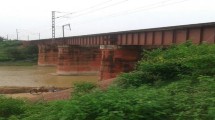Abstract
A key aspect of the seismic performance of bridges is the energy dissipation mechanism. The most usual mechanisms are the formation of plastic hinges in the piers, seismic isolation, and the addition of supplemental damping devices (such as hydraulic or hysteretic dampers). The present study assesses the feasibility of an energy dissipation device that has not been used in bridges before, consisting of special steel links installed at the abutments. First, the behaviour of these devices is evaluated, and an analytical (finite element) model is developed, informed by test results. Then the response of an actual railway bridge to a number of input motions is studied; in one case the bridge is equipped with hydraulic dampers and in the second with the proposed steel links. It is found that the energy dissipation and the performance of the bridge are similar in both cases, which is a first indication that the proposed system, which has a lower cost than hydraulic dampers, is worth exploring further as an alternative option for providing supplemental energy dissipation in bridges.














Similar content being viewed by others
References
ABAQUS 6.12 (2012) Standard user’s manual. Dassault Systèmes Simulia Corp, Providence
Ali HEM, Abdel-Ghaffar AM (1994) Seismic energy dissipation for cable-stayed bridges using passive devices. Earthq Eng Struct Dyn 23(8):877–893
Benavent-Climent A, Morillas L, Vico JM (2011) A study on using wide-flange section web under out-of-plane flexure for passive energy dissipation. Earthq Eng Struct Dynam 40(5):473–490
Camara A, Cristianeli R, Astiz MA, Malaga-Chuquitaype C (2017) Design of hysteretic dampers with optimal ductility for the transverse seismic control of cable-stayed bridges. Earthq Eng Struct Dynam 46(11):1811–1833
CEN (2004a) Eurocode 3: Design of steel structures—part 1-1: general rules and rules for buildings, EN 1993-1: 2004, European Committee of Standardisation
CEN (2004b) Eurocode 8: Design of structures for earthquake resistance—part 2: seismic design of bridges, EN 1998-2: 2004, European Committee of Standardisation
CEN (2004c) Eurocode 8: Design of structures for earthquake resistance—part 1: general rules, seismic actions and rules for buildings, EN 1998-1: 2004, European Committee of Standardisation
Chan WKR, Albermani F (2008) Experimental study of steel slit damper for passive energy dissipation. Eng Struct 30(4):1058–1066
Deng K, Pan P, Wang C (2013) Development of crawler steel damper for bridges. J Constr Steel Res 85:140–150
Deng K, Pan P, Su Y, Ran T, Xue Y (2014) Development of an energy dissipation restrainer for bridges using a steel shear panel. J Constr Steel Res 101:83–95
Golzan SB, Langlois S, Legeron FP (2016) Implementation of a simplified method in design of hysteretic dampers for isolated highway bridges. J Bridge Eng ASCE, ISSN 1084-0702
Kappos AJ (2002) “RCCOLA-90: reinforced concrete column analysis-90”, program for the inelastic analysis of reinforced concrete cross-sections, London, June 1996 (revised at AUTh in August 2002)
Karalis AA, Stylianidis KC (2013) Experimental investigation of existing R/C frames strengthened by high dissipation steel link elements. Earthq Struct 5(2):143–160
Penelis GG, Kappos AJ (1990) Earthquake resistant structures from reinforced concrete. Ziti Publications, Thessaloniki
SAP 2000 Ultimate 19.2.1, Structural analysis program, Computers and Structures, Inc
Sextos A, Pitilakis K, Kappos A (2003) Inelastic dynamic analysis of RC bridges accounting for spatial variability of ground motion, site effects and soil-structure interaction phenomena Part 1: methodology and analytical tools. Earthq Eng Struct Dyn 32(4):602–627
Tsai KC, Chen HW, Hong CP, Su YF (1993) Design of steel triangular plate energy absorbers seismic-resistant construction. Earthq Spectra 9(3):505–528
Author information
Authors and Affiliations
Corresponding author
Additional information
Publisher's Note
Springer Nature remains neutral with regard to jurisdictional claims in published maps and institutional affiliations.
Rights and permissions
About this article
Cite this article
Salonikios, T.N., Kolotsios, G. & Kappos, A.J. Alternative solutions for supplemental energy dissipation in bridges. Bull Earthquake Eng 18, 399–422 (2020). https://doi.org/10.1007/s10518-019-00733-x
Received:
Accepted:
Published:
Issue Date:
DOI: https://doi.org/10.1007/s10518-019-00733-x




